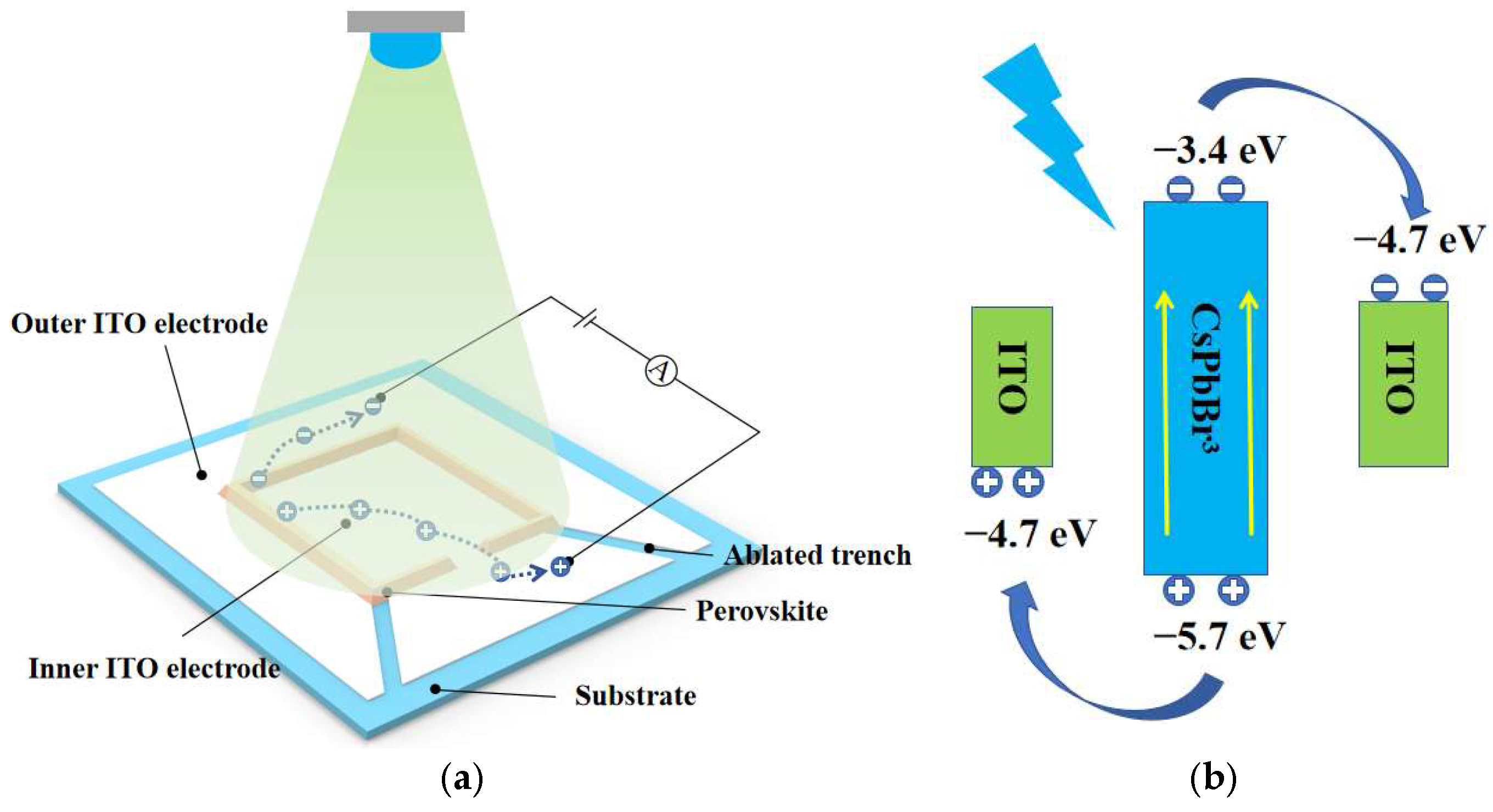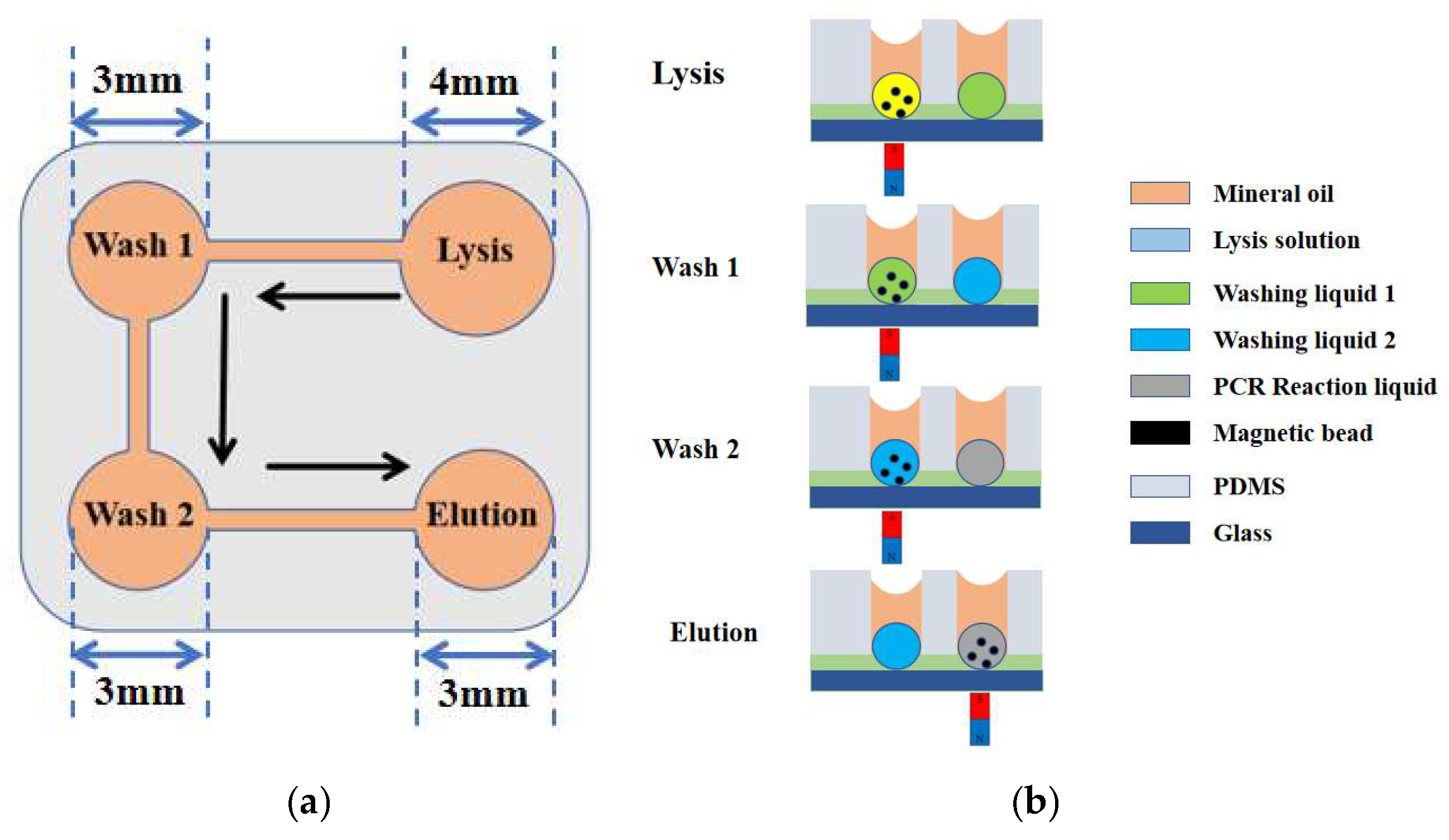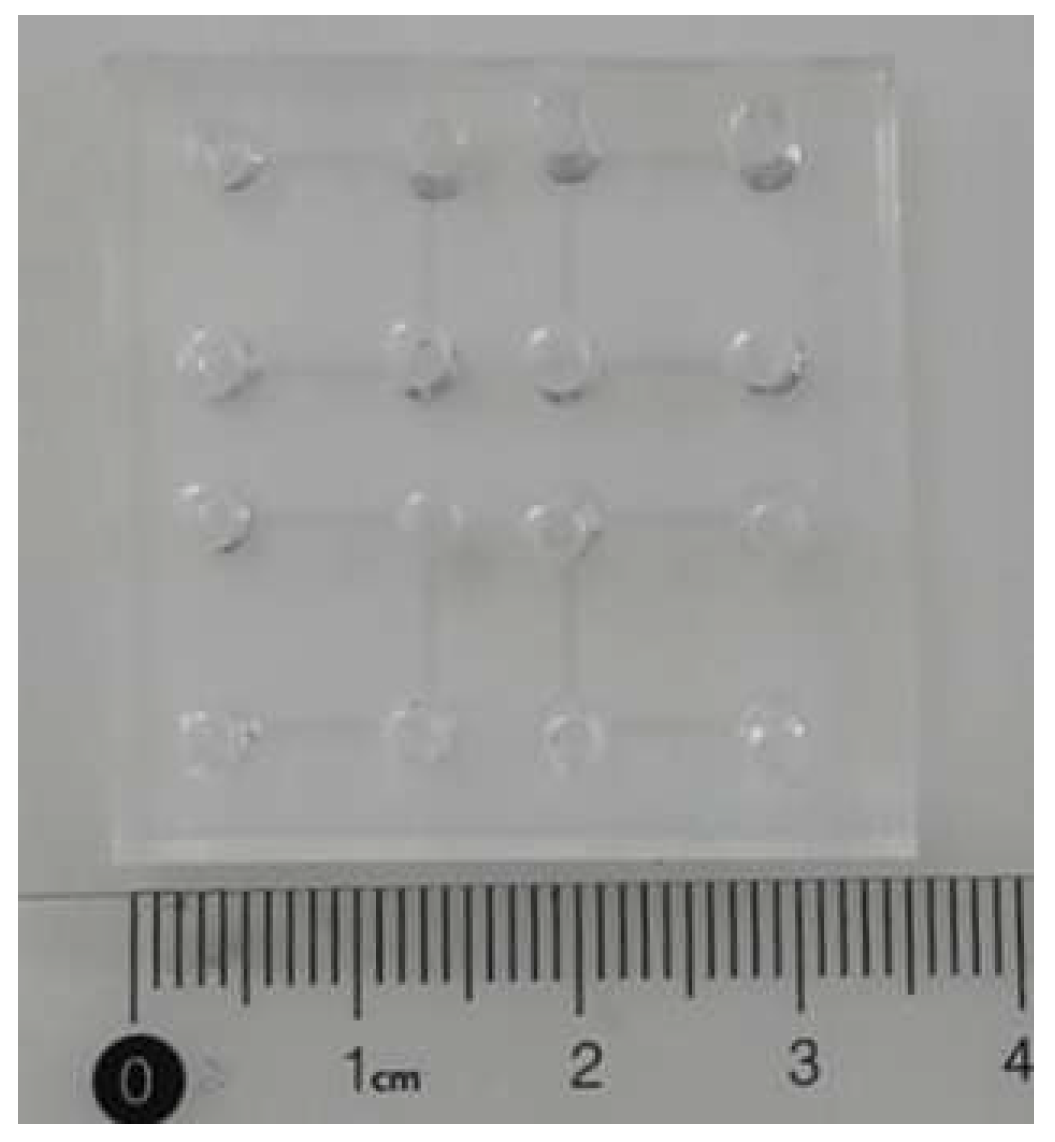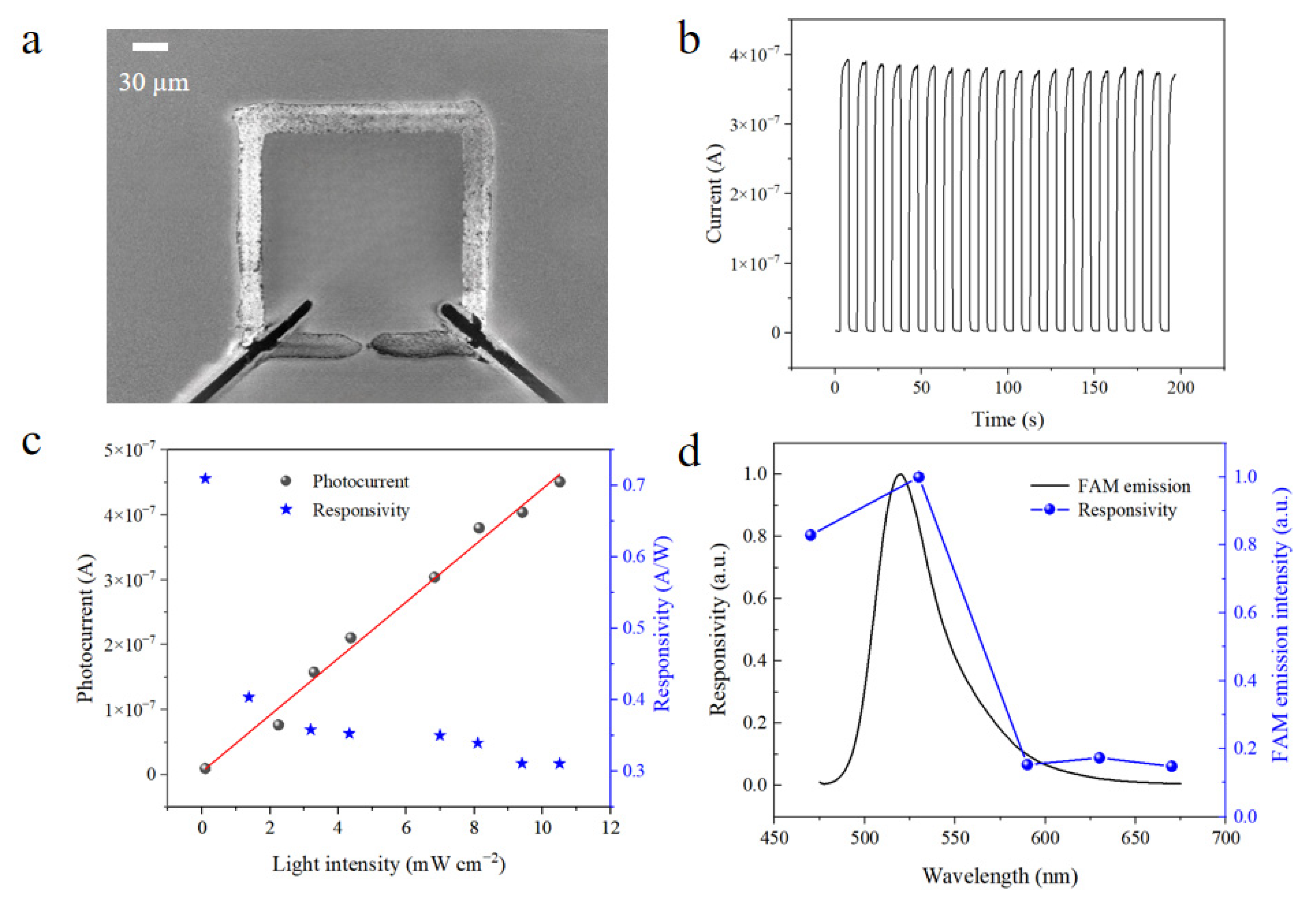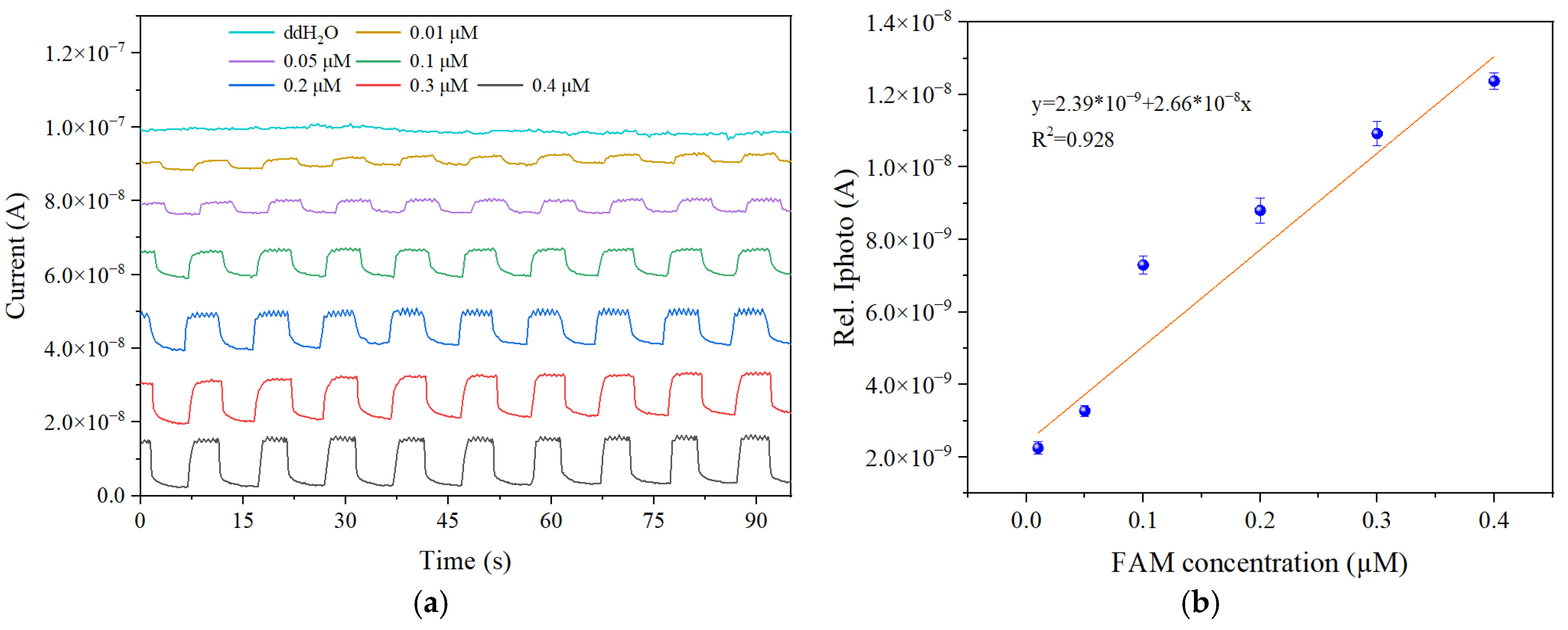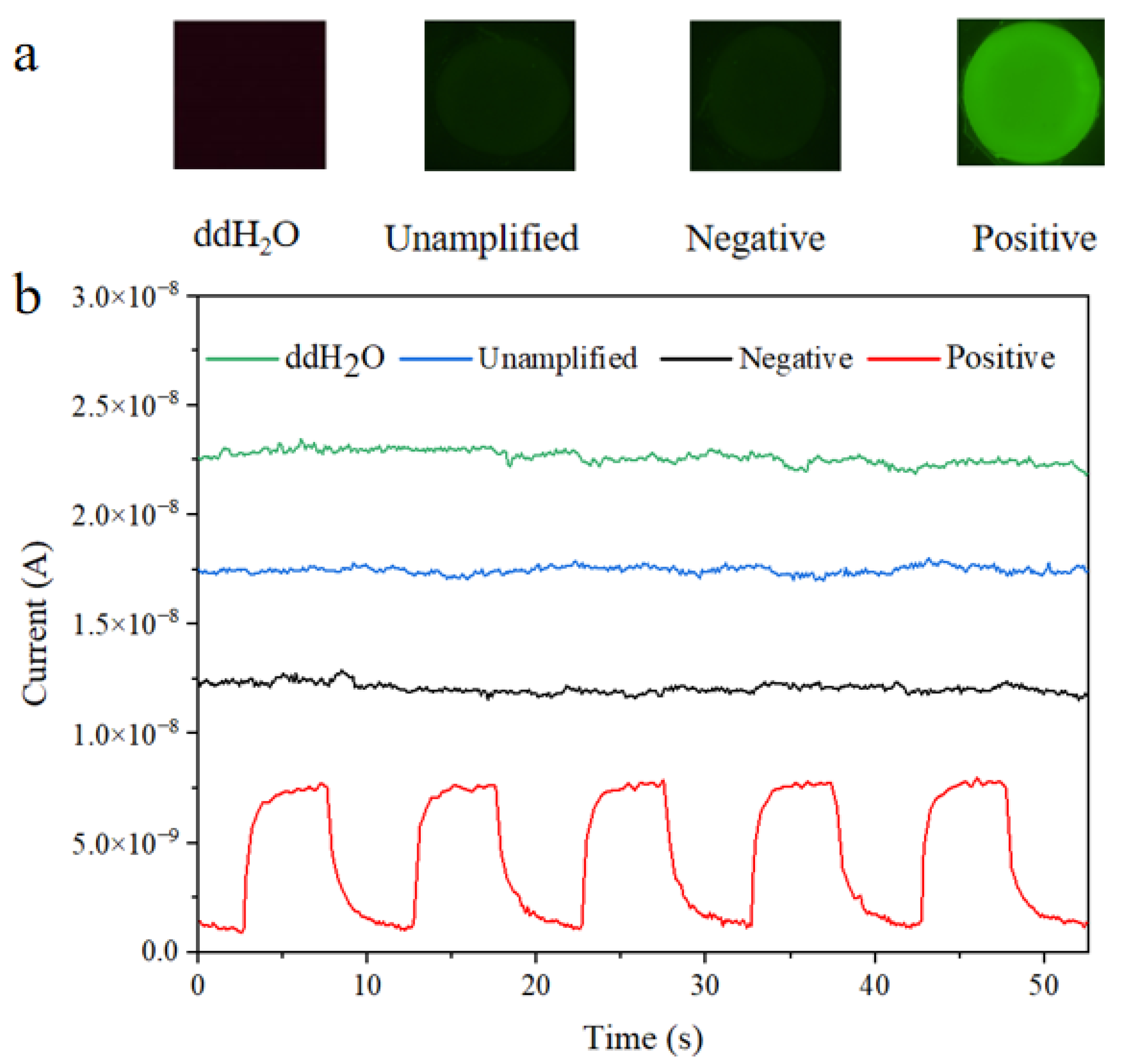1. Introduction
The rapid progression of globalization and urbanization has markedly increased human mobility, population density, and international connectivity, collectively contributing to the accelerated transmission of infectious diseases [
1]. Under these conditions, pathogenic microorganisms—including bacteria, viruses, and other infectious agents—can spread rapidly, often demonstrating high transmissibility and acute clinical onset. These characteristics present significant challenges to global public health systems and raise the likelihood of large-scale outbreaks. In this context, the timely identification and control of pathogens are critical, underscoring the urgent need for diagnostic technologies that are not only rapid and highly sensitive but also portable and accessible in diverse settings [
2].
To address these challenges, various pathogen detection strategies have been developed, with immunoassays and molecular diagnostics currently representing the most widely utilized approaches [
3]. Immunoassays are commonly adopted in clinical diagnostics due to their operational simplicity, rapid results, and cost-effectiveness. However, their effectiveness in early-stage detection is often hindered by the delayed onset of the host’s immune response, particularly the time required for antibody production [
4]. In contrast, molecular diagnostics—which directly target pathogen-specific nucleic acid sequences (DNA or RNA)—offer enhanced sensitivity and specificity, making them more suitable for early-stage screening and precise identification of infectious agents [
5]. The continued development of nucleic acid amplification methods, such as polymerase chain reaction (PCR) and loop-mediated isothermal amplification (LAMP) [
6,
7], has further expanded the applicability of molecular diagnostics across multiple domains, including infectious disease surveillance, food safety monitoring, and biosafety management. To further improve the practicality and performance of molecular diagnostic platforms, microfluidic chip technology has been increasingly integrated into nucleic acid detection systems. Microfluidics offers notable advantages such as minimal sample and reagent consumption, high precision in fluid control, and strong potential for system integration, making it an ideal foundation for portable and automated diagnostic devices. Diverse detection modalities have been effectively coupled with microfluidic platforms, including electrochemical sensing [
8], mechanical sensing [
9], and fluorescence-based detection [
10,
11]. Among these, fluorescence detection stands out as the most prevalent method due to its high sensitivity, specificity, and ease of operation [
12]. Conventional fluorescence detection techniques typically involve labeling amplified nucleic acids with fluorescent dyes or probes, followed by signal acquisition using fluorescence microscopy or CCD/CMOS imaging systems [
13]. However, these imaging-based approaches often rely on complex image processing for quantification, which introduces subjectivity and susceptibility to human error, thereby limiting standardization and throughput.
To overcome these limitations, the direct conversion of fluorescence signals into electrical outputs has emerged as a promising strategy to enhance quantification accuracy and detection efficiency [
14]. Central to this approach is the photodetector, whose performance—particularly in terms of sensitivity, response time, and spectral range—directly influences the quality of signal acquisition. Conventional photodetectors, such as photodiodes (PDs) and photomultiplier tubes (PMTs), have been extensively employed in fluorescence detection systems [
15]. Despite their widespread use, PDs suffer from low sensitivity and narrow spectral bandwidth, whereas PMTs, although highly sensitive, are bulky and cost-prohibitive, making them less suitable for portable, low-cost diagnostic devices [
16]. These limitations highlight the need for novel photodetection technologies optimized for point-of-care applications.
In recent years, perovskite-based sensors have attracted extensive attention from the academic community due to their outstanding optical properties, including high absorption coefficients, strong photoluminescence, excellent photoelectric conversion efficiency, and tunable bandgaps [
17,
18]. For example, An et al. [
19] encapsulated CsPbBr
3 perovskite nanocrystals in polystyrene/polyacrylamide microspheres to construct a urea sensor, achieving a detection limit of 1.67 μmol L
−1 and demonstrating effective biomolecule sensing capabilities. Wang et al. [
20] utilized the luminescent properties of CsPbBr
3 in combination with the hydrophobicity of BN materials to achieve the highly sensitive detection of tetracycline, with a detection limit as low as 6.5 ng·mL
−1. In addition, Xiang et al. [
21] developed a humidity photodetector based on the water sensitivity of CsPbBr
3 for monitoring moisture content in herbal medicines, with a minimum detection limit of 12% RH. These studies indicate that perovskite sensors not only offer high sensitivity, environmental adaptability, and stable photoelectric response, but also exhibit tunable bandgap characteristics that enable flexible spectral matching for different fluorescence signals [
22]. Notably, CsPbBr
3 shows peak responsivity around 530 nm, which closely matches the emission spectrum of the commonly used fluorophore 5(6)-Carboxyfluorescein (FAM), making it particularly suitable for direct fluorescence detection without the need for wavelength conversion or optical filtering. These advantages allow for reliable detection even in complex sample environments, highlighting the enormous potential of perovskite-based sensors in the field of fluorescence sensing [
23].
This study proposes and demonstrates a nucleic acid fluorescence detection platform that integrates a microfluidic chip with an all-inorganic CsPbBr3 perovskite photodetector. The system incorporates nucleic acid extraction, fluorescence labeling, and signal readout into a unified workflow, enabling the efficient conversion of FAM fluorescence signals into electrical outputs and eliminating the need for traditional image-based analysis. This significantly enhances the sensitivity and portability of the detection process. The experimental results show that the photodetector exhibits excellent spectral responsivity at the main emission wavelength of FAM (520 nm), thereby improving detection specificity and photoelectric conversion efficiency. Validation using FAM standard solutions and Escherichia coli nucleic acid samples demonstrates the system’s favorable linearity, signal stability, and repeatability, further confirming its strong potential for rapid on-site pathogen screening.
3. Results and Discussion
3.1. Photoelectric Properties of the CsPbBr3 Photodetector
The performance of the photodetector was evaluated in a controlled dark environment. A signal generator (AFG3251C, Tektronix, Beaverton, OR, USA) was used to power a blue LED, which served as the excitation light source, while a semiconductor parameter analyzer (4200A−SCS, Keithley, Cleveland, OH, USA) was employed to measure the photoelectric response of the device. A bias voltage of 5 V was applied to the perovskite photodetector during signal acquisition process.
Figure 5a presents the scanning electron microscopy (SEM) image of the perovskite photodetector fabricated using CsPbBr
3 material. The device features an insulating trench formed by laser ablation, which effectively separates the ITO electrode regions and enables lateral current flow between the internal and external regions. This structural design significantly shortens the carrier transport path and enhances the utilization efficiency of excitation light within the photoactive perovskite layer.
Figure 5b displays the time-resolved photoresponse curve of the device under periodic illumination at 530 nm. Stable and highly repeatable photocurrent pulse responses were clearly observed, with consistent peak and baseline levels maintained over multiple excitation cycles. These results indicate excellent device stability and durability under continuous illumination, which is essential for real-time monitoring and practical applications. This further validates the reliable performance of the CsPbBr
3-based photodetector.
Figure 5c shows the photocurrent response of the device under 530 nm illumination at varying light intensities of illumination. As the incident power density increased from 0.01 mW cm
−2 to 10.24 mW cm
−2, the photocurrent exhibited linear growth, indicating good linearity over a broad range of illumination intensities. This behavior can be explained by the photogeneration of electron–hole pairs [
25]: as light intensity increases, more photons are absorbed by the perovskite film, leading to the generation of more photocarriers and, consequently, enhanced photocurrent output. The figure also shows the device responsivity (defined as the ratio of photocurrent to incident optical power). A decreasing trend in responsivity is observed with increasing light intensity, which can be attributed to enhanced carrier recombination rates [
26] that limit further photocurrent increase, resulting in a sublinear responsivity behavior.
Figure 5d illustrates the wavelength-dependent responsivity of the device along with the emission spectrum of FAM fluorescent dye (See
Supplementary Materials for details). The CsPbBr
3 photodetector exhibits a peak responsivity at 530 nm, which closely matches the primary emission wavelength of FAM. This excellent spectral alignment confirms the device’s capability for efficient FAM fluorescence detection, providing a solid foundation for high-sensitivity signal acquisition in nucleic acid detection systems.
3.2. Linearity Test of FAM Fluorophore Detection
To evaluate the performance of the perovskite-based fluorescence detection system, FAM fluorescent solutions were prepared by first dissolving 7.52 mg of 5(6)-carboxyfluorescein in 1 mL of DMSO to obtain a 0.1 mol L−1 stock solution. This stock solution was subsequently diluted with ddH2O to obtain working solutions with concentrations of 0.01 μM, 0.05 μM, 0.1 μM, 0.2 μM, 0.3 μM, and 0.4 μM. During fluorescence detection, 10 μL of the prepared FAM solution was injected into the microfluidic chip, and a pulsed light source with a cycle period of 10 s and a duty cycle of 50% was employed to excite the fluorescent molecules. The photocurrent response generated by the perovskite photodetector was then recorded to assess the system’s sensitivity and signal stability under varying FAM concentrations. All experiments were conducted at room temperature (approximately 25 °C) to ensure thermal consistency and eliminate temperature-related signal variations.
Figure 6a presents the current response curves corresponding to different concentrations of FAM solutions (0 μM, 0.01 μM, 0.05 μM, 0.1 μM, 0.2 μM, 0.3 μM, and 0.4 μM). Initially, ddH
2O was used as a control to establish the baseline. The results indicated that the photodetector exhibited negligible current fluctuations in the absence of fluorescein, suggesting a near-zero baseline response and excellent background suppression. Subsequently, the current response was measured with increasing FAM concentrations, starting at 0.01 μM. The experimental results demonstrated that the current signal was noticeably enhanced at 0.01 μM, significantly exceeding the baseline noise level. This indicates that the photodetector was able to generate a detectable photoresponse at this low concentration. It is worth emphasizing that all fluorescence detection experiments across the full concentration range shown in
Figure 6a were conducted using the same CsPbBr
3 perovskite photodetector, without any observable performance degradation over repeated excitation cycles and varying FAM concentrations. This result clearly demonstrates the excellent reusability of the perovskite photodetector, indicating its stability and practical feasibility for repeated or continuous fluorescence detection tasks in real-world applications. A higher sensitivity implies a greater ability to detect subtle changes in biomolecular concentration [
27,
28]. When the FAM concentration increased from 0.01 μM to 0.4 μM, the photocurrent exhibited a change of more than 10 nA, corresponding to a sensitivity exceeding 25.6 nA μM
−1. This indicates that the sensor can generate a distinct and measurable signal amplitude response to changes in analyte concentration, demonstrating excellent responsiveness to weak fluorescence signals and fulfilling the requirements for detecting low concentrations of nucleic acids or biomarkers.
To obtain accurate response values, the current data during each excitation phase and dark stabilization phase were averaged, and the difference between the two was used to extract the effective photoresponse signal (as shown in
Figure 6b). Within the FAM concentration range of 0.01 μM to 0.4 μM, the system exhibited a strong linear relationship between photocurrent and concentration. The linear fitting equation was y = 2.39 × 10
−9 + 2.66 × 10
−8 x, with a correlation coefficient of R
2 = 0.928, indicating strong linearity.
For each concentration tested in the experiment, the signal-to-noise ratio (SNR) was calculated using Equation (1).
where
Ilight and
Idark represent the average photocurrents under illumination and in darkness, respectively, and
denotes the standard deviation of the photocurrent under illumination. Based on the experimental data, the system achieved SNR values exceeding 20 dB starting from a concentration of 0.05 μM. Even at the lowest tested concentration of 0.01 μM, the system maintained a detectable signal with an SNR of 16.44 dB, which is above the standard threshold of 10 dB required for reliable quantitative detection. This confirms that the signal is distinguishable from background noise and can be used for low-concentration fluorescence signal identification and preliminary quantification.
Based on the criterion that the photocurrent signal must be significantly higher than the background noise, the experimental limit of detection (LoD) for the system was determined to be 0.01 μM. Within the concentration range of 0.01–0.4 μM, the system exhibited a strong linear correlation between photocurrent and FAM concentration, confirming the effective detection capability, high sensitivity, and good quantification performance of the developed perovskite-based detection platform. In future work, further improvements in detection precision may be achieved by optimizing the optical path, minimizing ambient light interference, and precisely adjusting lens focal distances.
3.3. Results and Analysis of Pathogen Detection
Biological application experiments are the most reliable and crucial means of evaluating the performance of a detection system. Based on the previously described PCR protocol, nucleic acid amplification was carried out using Escherichia coli nucleic acid at a concentration of 100 copies·μL−1 as the positive sample. Unamplified samples, negative samples, and ddH2O were used as control groups. After amplification, all samples were tested using both a commercial fluorescence microscope and the fluorescence detection system developed in this study. The detection procedure followed the same protocol as that employed in the FAM solution experiments.
Figure 7a shows the fluorescence microscopy images of the tested samples, arranged from left to right: ddH
2O, unamplified sample, negative sample, and positive sample. A distinct green fluorescence signal was observed in the positive sample, whereas the negative, unamplified, and ddH
2O control samples exhibited only weak background fluorescence. This residual signal is attributed to nonspecific fluorescence from primers and probes.
Figure 7b presents the time-resolved output current curves obtained from the perovskite-based fluorescence detection system. From bottom to top, the curves correspond to the positive, negative, unamplified, and ddH
2O control samples, respectively. Under blue light excitation, the positive sample produced a pronounced pulsed photocurrent response, whereas the other three control samples showed minimal current variation and no significant photoresponse. The trend in photocurrent output closely mirrored the fluorescence intensity observed in the microscope images, further confirming the system’s sensitivity and reliability in detecting fluorescence signals from PCR-amplified nucleic acids.
4. Conclusions
This study proposes and validates a fluorescence-based nucleic acid detection platform that integrates a microfluidic chip with an all-inorganic perovskite photodetector, providing a novel and practical solution for rapid pathogen detection. The platform enables automated microscale nucleic acid extraction and amplification, followed by efficient fluorescence signal acquisition and quantification through a CsPbBr3 perovskite photodetector. This study proposes and validates a fluorescence-based nucleic acid detection platform that integrates a microfluidic chip with an all-inorganic perovskite photodetector, providing a novel and practical solution for rapid pathogen detection. The platform enables automated microscale nucleic acid extraction and amplification, followed by efficient fluorescence signal acquisition and quantification through a CsPbBr3 perovskite photodetector. The experimental results show that the CsPbBr3 detector exhibits peak responsivity at 520 nm, corresponding to the main emission wavelength of FAM. The system demonstrates a strong linear correlation between photocurrent and FAM concentration over the range of 0.01–0.4 μM (R2 = 0.928), with a low detection limit of 0.01 μM and excellent reproducibility across multiple measurements. Further validation using Escherichia coli nucleic acid samples confirms that the electrical signal output can accurately distinguish between positive and negative specimens, with the results highly consistent with fluorescence microscopy. A key innovation of this work lies in the integration of perovskite materials into a fluorescence detection system. The approach supports low-cost fabrication and leverages the tunable bandgap properties of perovskites to achieve spectral alignment with various fluorophores such as FAM and 6-Carboxy-X-Rhodamine (ROX), laying the foundation for future multiplexed detection. In addition, the micro/nanofabrication process of the perovskite photodetector enables microscale array layouts, offering a promising pathway toward high-throughput, multi-target, and miniaturized diagnostic devices. In summary, the integrated microfluidic–perovskite detection platform features high sensitivity, digital signal output, low cost, and strong scalability, making it particularly well-suited for rapid pathogen screening and point-of-care diagnostics in resource-limited settings.

